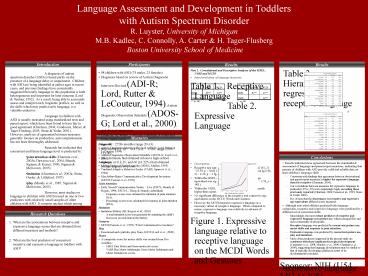Language Assessment and Development in Toddlers - PowerPoint PPT Presentation
1 / 1
Title:
Language Assessment and Development in Toddlers
Description:
Autism Diagnostic Interview-Revised (ADI-R; Lord, Rutter & LeCouteur, 1994) ... Vineland Adaptive Behavior Scales (VABS; Sparrow et al., 1984) ... – PowerPoint PPT presentation
Number of Views:55
Avg rating:3.0/5.0
Title: Language Assessment and Development in Toddlers
1
Language Assessment and Development in Toddlers
with Autism Spectrum Disorder R. Luyster,
University of Michigan M.B. Kadlec, C. Connolly,
A. Carter H. Tager-Flusberg Boston University
School of Medicine
Introduction
Results
Results
Table 3. Hierarchical regression for receptive
language Table 4. Hierarchical
regression for expressive language
- Part 1. Correlational and Descriptive Analyses
of the MSEL, VABS and MCDI - Intercorrelations of language measures
- Table 1. Receptive Language Table 2.
Expressive Language - Descriptives
- Receptive age equivalents differed across
measures ?2 (61, 2) 27.79, p lt .001 but
expressive age equivalents did not ?2 (56, 2)
4.39, p .11. - Within the MSEL subdomains, expressive language
age equivalent was significantly greater than
receptive (Z 3.54, p lt .001). - Within the VABS, receptive language age was
significantly higher than expressive (Z 6.12, p
lt .001). - No significant difference in the receptive and
expressive age equivalents on the MCDI Words and
Gestures. - However, the MCDI measures expressive language as
a necessary subset of receptive language. When
compared to norms, expressive language was
relatively in advance of receptive language. - Figure 1. Expressive language relative to
receptive language on the MCDI Words and Gestures
- A diagnosis of autism spectrum disorder (ASD)
is based partly on the presence of a language
delay or impairment. Children with ASD are being
identified at earlier ages in recent years, and
previous findings have consistently suggested
that early language in this population is both
heterogeneous and important for later outcome
(Lord Ventner, 1992). As a result, being able
to accurately assess and interpret early
linguistic profiles, as well as the skills which
may predict early language, is a valuable
endeavor. - Language in children with ASD is usually
measured using standardized tests and parent
report, which have been found to have fair to
good agreement (Charman, 2004 Condouris, Meyer,
Tager-Flusberg, 2003 Stone Yoder, 2001).
However, analyses of agreement between measures
generally focuses on production, and
comprehension has not been throroughly addressed.
- Research has indicated that concurrent and
future language level is predicted by - joint attention skills (Charman et al., 2003a
Dawson et al., 2004 Mundy, Sigman, Kasari,
1990 Sigman McGovern, 2005) - imitation (Charman et al., 2003a Stone, Ousley,
Littleford, 1997) - play (Mundy et al., 1987 Sigman McGovern,
2005). - However, most studies on language in children
with ASD focused on one or two predictors with
relatively small samples of older children with
ASD. It remains unclear which among these
various factors are the most significant
predictors of language.
Conclusions
- Results indicated close agreement between the
standardized assessment of language and parent
report measures, indicating that parents of
children with ASD provide valid and reliable data
on their childrens language skills - Consistent with findings that agreement between
observational and parent report measures is
higher for expressive language than for receptive
(Charman, 2004). - Our correlations between measures for expressive
language in particular (.87 to .92) were
surprisingly high, exceeding those previously
reported (Charman, 2004 Fenson et al., 1993
Stone Yoder, 2001). - It is of note that the discrepancy in receptive
and expressive age equivalents differed across
measures. - Although nonverbal abilities predicted both
language composites, receptive and expressive
language were predicted by a different set of
concurrent skills. - Interestingly, the most robust predictor of
receptive and expressive language was gesture
use, which emerged first and most consistently in
all models. - Receptive language was predicted by concurrent
gesture use, motor skills and response to joint
attention. - Expressive language was predicted by concurrent
gesture use, play and imitation. - Most of the predictors supported in the present
study are consistent with those implicated in
typical development (Carpenter et al., 1998
Morales et al., 2000 Charman et al., 2000),
suggesting that language development may be
similar to that of typically developing children
in terms of its developmental correlates.
Sponsor NIH (U54 MH 66398)
National Center for Research Resources (M01
RR00533 GCRC)































